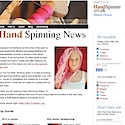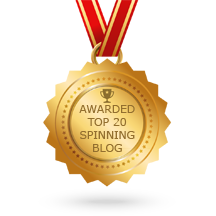Review - Hand Spinning - Essential Technical and Creative Skills by Pam Austin
My first impression was that the book undersells itself. The cover certainly could be more eye-catching.
But it's a very well-produced book. 10.5" x 9", glossy, hard-covers with 144 pages and 200 illustrations.
It is aimed at the beginner, with some value for the intermediate spinner too.
Pam runs the Spinning School www.spinningschool.org; she gave me an impromptu lesson in longdraw spinning once at Fibre East and I like her very much.
I associate her with longdraw (woollen) spinning so it's no surprise that there's an emphasis on this technique. It's the first draft that she covers in the book, followed by several others; worsted, short forward, semi-worsted, core-spinning.
I asked myself whether it would be possible to learn to spin using the book and the answer is yes. It begins with an exercise in spinning a small piece of yarn without using a spindle, which helps you to understand how the fibres hold together when twisted and the construction of yarn.
It then proceeds to teach you how to spin using a spindle (which I believe any good teacher would do before going to a wheel) with plenty of pictures.
Much that you'll need to know is covered; the anatomy of a wheel and choosing the right one, recognising a good fleece, other fibres, animal and plant, carding, plying, Andean plying, colour theory, dyeing. It finishes with the spiritual 'Mindfulness and art'. The list of chapters below doesn't tell the full story, for example, carding is well covered; rolags punis, hand carders, flick carder, blending board, drum carders. But this is within chapter 4 and not mentioned in the chapter title.
While imagining myself as a new spinner, I did notice that it may be necessary to skip around a little bit. As I mentioned, the book begins with the first steps toward producing your own yarn. But it's then necessary to move forward several chapters (or read them) before finding plying.
Colour theory has a whole chapter. Dyeing has a chapter too. It covers commercial dyes and some techniques, and then two natural dyeing techniques: indigo and walnuts. Pam explains at the end of the chapter "The techniques in this chapter were chosen for their ease of use and satisfying results." This desire to convey the magic of the craft is clearly something that Pam feels, and I did feel that running through the book.
"Bewitched and bewildered" is an intriguing chapter title. She says (quite rightly) "It's so easy to become bewitched by beautiful wheels and bewildered by conflicting advice." The chapter aims to help steer you through all of this and make the right decisions for you.
The style is reassuringly formal. Not too matter-of-fact and not too casual. Something that I found satisfying is that each chapter begins "The aim of this chapter is..." and ends "In a nutshell..." with a summary.
Chapters:
Introduction
1. One thread at a time
2. Bewitched and bewildered
3. Essential spinning techniques
4. Sheep fleece: nature's best
5. Fibres for hand spinning
6. Plying and finishing yarn
7. Colour in spinning
8. Dyeing to dye
9. Yarn structure
10. Mindfulness and art
Further reading
Glossary
Natural colours and natural dyeing are part of Pam's outlook but I'm sure that it would have been possible to have conveyed this with a more eye-catching cover. This goes for some of the photographs in the instructional section, which lack a bit of brightness and clarity.
That aside, it's a large, glossy, hardback book It would be a good companion to a new spinner, Pam's attitude as a teacher is evident and she aims to inspire mindfulness, art and creativity in her readers.
I've tried to be objective. I have a copy which I'm giving away in August's Hand Spinning News.
You can buy a copy of the book directly from Pam's site:
http://www.spinningschool.org/product/hand-spinning-essential-technical-and-creative-skills/
Labels:
book review,
drop spindle,
spinning,
spinning wheel
Subscribe to:
Posts (Atom)





